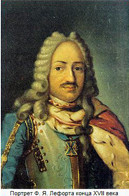
The subject of foreigners’ service for the welfare of Russia developed in the Presidential Library’s collections
Destinies of famous foreigners working in Russia in different historical periods who had proved themselves patriots of the “new” country, are presented in the collections of the Presidential Library.
The collections "State authority" and "Russian people" feature rare books and documents about the associates of Peter I. Among them are Prince Dmitry Cantemir, adviser of Peter I on the oriental issues; Pyotr Gordon, General and Rear Admiral; Franz Lefort - General-Admiral, and many others.
For example, M. Posselt described the biography of the first Russian Navy Admiral, who, in his opinion, "zealously and tirelessly helped his tsar in the creation of the fleet and took an active part in its first glorious victories" on the basis of letters from the family archive of the Leforts in Switzerland and other sources in a rare edition of the 19th century, "Russian Navy Admiral Franz Yakovlevich Lefort or the beginning of the Russian Navy." The author writes that Peter forced Lefort "to take part in all the works and wanted to keep him close to himself as an advisor or employee." Lefort commanded a regiment in the demonstration land battles near Moscow, and led the ship "Mars" during naval exercises in the Pereiaslavl Lake.
He accompanied Peter in two of his travels to Arkhangelsk and was named captain of the ship that arrived from Holland. Lefort participated in the "toy army" Kozhukhovsky maneuvers near Moscow, which nearly turned into a tragedy for him. Peter’s toy army campaigns were a training for the real and difficult war with Turkey and the Crimea - the Azov campaigns of 1695 and 1696's, in which Lefort took an active part. He commanded a corps during the first storm of Azov in 1695 and personally seized one of the Turkish flags. After the first campaign, Peter appointed him admiral of the Russian fleet.
The Presidential Library’s collections also include a series of films under the title "German Princesses - Russian destinies..." which tells about the German princesses who had become Empresses of Russia.
It is interesting to know how Catherine the Great, the first German princess Sophia Anhalt Zerbst, whom the Empress Elizabeth chose as a wife for her nephew Peter III, ascended the Russian throne.
For the sake of power the German princess adopted Orthodoxy, ousted her husband and son from the throne. It was Catherine the Great who had played a special role in the history of the Russian state. During her reign administrative and judicial reforms were carried out, the economy and trade strongly developed. Much attention was paid to the development of science and education. She opened Smolny Institute for Noble Maidens, Russian Academy of Sciences, established an observatory, physics laboratory, anatomical theater, botanical garden, tool shops, printing, library. In Catherine’s reign Hermitage and Public Library were built in St. Petersburg.
The second film tells about two empresses - Maria Feodorovna, the widow of Paul I, and her daughter-in-law Elizabeth Alekseevna (Louise of Baden). The first was a very power-loving, while the second - a gentle, Alexander Pushkin himself admired her. The authors of the film give little-known facts, including, for example, matchmaking of Napoleon to the sister of Emperor Alexander I. The third film is the story of the fate of the three empresses - Alexandra Feodorovna, wife of Nicholas I; Maria Alexandrovna, wife of Alexander II; and the last Empress Alexandra Feodorovna, wife of Nicholas II, whose highest and tragic fate will forever remain in the history of the world. The films were made by the "Lennauchfilm" and delivered to the library in digital form.

